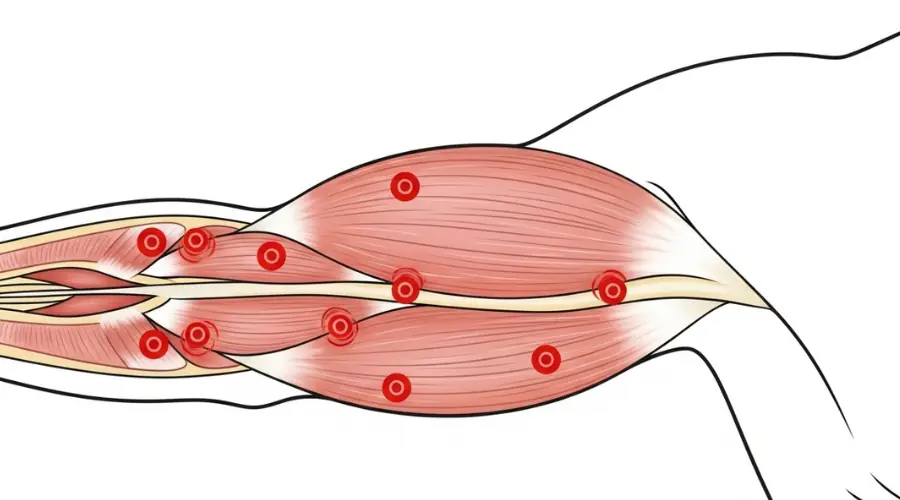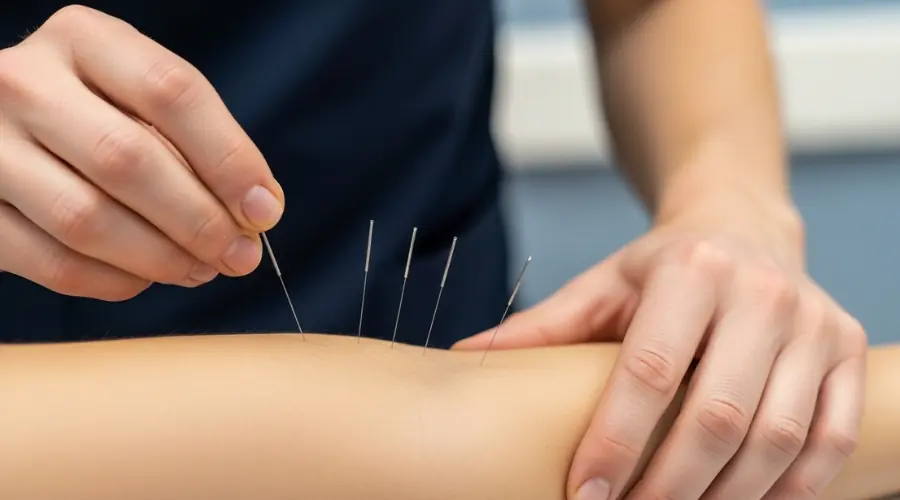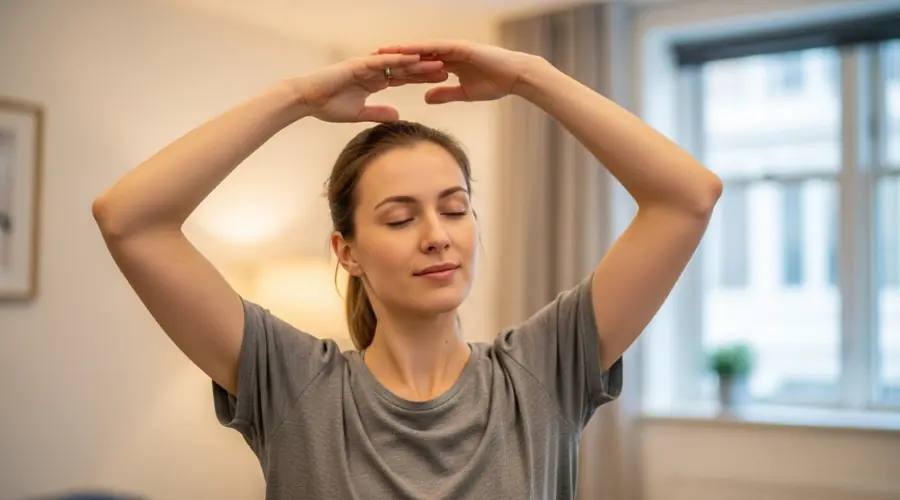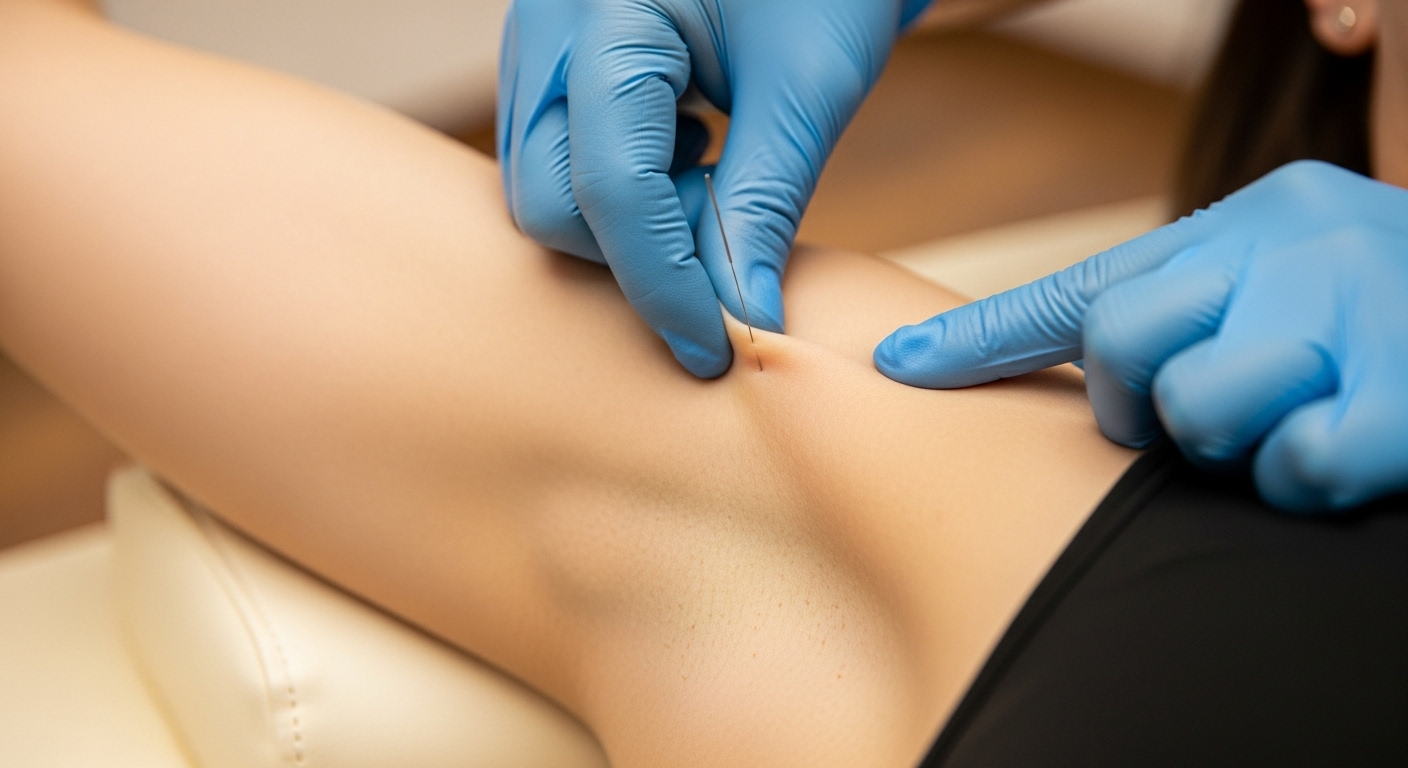Dry Needling is a physical therapy technique that has gained significant attention in recent years as an effective solution for managing musculoskeletal and muscle pain, particularly in the upper extremity. This article provides a simple, evidence-based review of how Dry Needling for arm can help you find pain relief and return to daily function, focusing on scientific evidence and safety considerations.
1. What is Dry Needling?
1.1. Dry Needling in Simple Terms
Dry Needling (DN) literally means "inserting a dry needle." In this technique, a trained therapist (such as a physical therapist or a specialized physician) uses very thin, single-use needles, similar to acupuncture needles, with the key difference that no fluid (such as medication or anesthetic) is injected.
The goal of DN is to insert the needle into specific points in the body. These points can include the muscles themselves, tendons, ligaments, or the tissues surrounding a nerve. The primary focus of DN is on treating areas called "Myofascial Trigger Points" (MTrPs).
1.2. What are Trigger Points?
Imagine a painful, tight knot in your muscle (for example, in the area treated by Dry Needling for upper arm). These stiffened muscle knots, formed due to stress, injury, or repetitive use, are the trigger points. These points are not only painful themselves but can also refer pain to other parts of the arm, elbow, or even the hand.

1.3. The 'Magic' Mechanism of Pain Relief
The effectiveness of Dry Needling for arm is achieved through natural stimulation of the body:
-
Breaking the Pain Cycle: When the needle is inserted directly into the muscle knot (trigger point), it sends a strong, sudden message to the nervous system and the spinal cord. This strong signal allows the body to "switch off" the chronic pain signal caused by the knot, leading to muscle relaxation.
-
Local Twitch Response (LTR): Sometimes, the needle insertion causes the muscle to perform a quick, small contraction called a Local Twitch Response (LTR). This twitch is usually a good sign that the therapist has reached the right area and the muscle is responding.
-
Improving Circulation and Nerves: Local stimulation from dry needling increases blood flow to the targeted area. This helps to resolve the oxygen deprivation (ischemia) in the muscle knots. It can also be beneficial for improving microcirculation around compressed nerves.
Important Note: Although dry needles are similar to acupuncture needles, the DN technique is based on Western anatomical and physiological knowledge (the muscular and nervous system) and is aimed at directly treating musculoskeletal pain.
2. Clinical Effectiveness of Dry Needling for Arm (Is This Method Effective for My Arm Pain?)
Scientific evidence confirms that Dry Needling for arm is an effective tool for managing muscle pain in the upper extremity, especially in the short term.
2.1. Rapid Pain Relief
Studies have shown that dry needling, particularly when compared to no treatment or placebo, can significantly reduce pain in short intervals (typically immediately up to 3 months after treatment). This temporary relief opens a crucial "window" for you to perform the necessary strengthening exercises for long-term recovery without severe pain.
In fact, due to its strong analgesic effect, DN is often used as an "adjunct" or "catalyst" alongside physical therapy and exercise.
2.2. Specific Applications in the Arm and Upper Extremity
Dry needling has shown positive results in various upper extremity pain conditions:
-
Elbow Pain (Lateral Epicondylitis): If you suffer from golfer's or tennis elbow, Dry Needling for elbow performs very well in short-term pain reduction, with results at least comparable to other standard treatments. This method can be very effective for cases that do not respond to traditional therapies.
-
Neurological Problems and Numbness: Dry needling can be helpful in relieving symptoms like tingling or Dry Needling for arm numbness (especially those caused by Carpal Tunnel Syndrome). In this case, needles are used to reduce pressure on the nerves and improve the surrounding conditions. It is beneficial for relieving pain and improving grip strength in patients with mild to moderate Carpal Tunnel Syndrome.
-
Under Arm and Arm Muscle Pain: For general muscle pain in the Dry Needling for under arm area and the Dry Needling for upper arm caused by muscle knots, this technique quickly reduces tension. This also applies to forearm muscles and Dry Needling for hand.
A Note on Other Pains: Dry needling is a versatile method for musculoskeletal pains. Dry needling for neck pain and back pain is also highly recommended and can be an effective adjunctive treatment for chronic pain in these areas.
2.3. Realistic Expectations on Strength
While Dry Needling for arm reduces pain well and allows the patient to regain function, evidence suggests that this method does not have a direct effect on increasing muscle strength. In other words, the functional improvement you feel is mostly due to pain reduction, which allows you to use your muscles' natural maximum force, not because the needle itself made your muscles stronger.

3. How Dry Needling is Performed
The execution of dry needling is a specialized process that must be performed by certified and specially trained therapists.
3.1. Treatment Steps
-
Assessment: The therapist first examines your arm to identify painful points, muscle knots, and referred pain patterns (e.g., in the Dry Needling for upper arm area).
-
Preparation: Your skin is cleaned at the intended site.
-
Needle Insertion: The therapist inserts a very thin needle into the targeted tissue (muscle or connective tissue). For areas with sensitive structures underneath the muscle, such as the Dry Needling for under arm area or deep muscles, the therapist may grasp the muscle between two fingers (pincer technique) to fully ensure safety.
-
Timing: The needles may be left in place for a short time, or the therapist may move them slightly to elicit a local twitch response.
3.2. Duration of Treatment
The number of sessions required for Dry Needling for arm varies depending on whether your problem is chronic or acute. Some individuals feel significant relief immediately after the first session, while others require more sessions to achieve the desired outcome.
4. Safety, Side Effects, and Pain Management (Is It Painful and Safe?)
Dry needling, when performed by a trained specialist with sufficient anatomical knowledge, is generally considered very safe.
4.1. The Pain Experience During Treatment
Dry needles are thinner than sewing needles. Therefore:
-
Upon Needle Entry: You may only feel a brief, mild "pricking" or "pressure" sensation.
-
When Stimulating the Knot: If a muscle knot is targeted, you may feel a quick contraction (twitch response) or a temporary, deep "dull ache," which is a sign that the treatment is effective.
4.2. Common Side Effects
The real discomfort usually appears after the session is over and is temporary. The most common side effects include:
-
Soreness and Local Pain: This is the most common side effect and usually resolves within a few hours to a maximum of one day.
-
Minor Bruising or Bleeding: Due to minor damage to small blood vessels, a small bruise may appear at the needle site, which is normal.
-
Feeling Tired or Headache: Some people experience general fatigue or a mild headache after treatment, which is usually temporary.
To reduce post-treatment soreness, warm compresses, gentle stretching, or light massage can be used.

5. Patient Outcomes and Expectations (What Results Can I Expect?)
The ultimate goal of Dry Needling for arm is to restore your ability to perform daily tasks without pain and limitation.
5.1. Expected Improvements
After treatment, most patients report improvements:
-
Pain Reduction: 73.8% of patients reported an improvement in pain.
-
Increased Mobility: 70.6% experience an improvement in range of motion and the ability to move.
-
Increased Strength in Activities: Approximately 38.5% of patients reported improvement in strength and function after Dry Needling for hand or forearm.
Functional improvements, such as the ability to lift objects more easily or perform household chores with less pain, are the most important outcomes of treatment. If your Dry Needling for arm numbness symptoms improve after treatment, this is a major therapeutic success.
5.2. Dry Needling: Part of a Larger Program
To achieve stableand long-term results, Dry Needling for arm should be only one part of your rehabilitation program. Your physical therapist will likely combine this method with a program of strengthening and stretching exercises.
By rapidly reducing pain, DN helps you to correctly perform exercises, strengthening your muscles for long-term support and preventing the return of muscle knots.
Final Conclusion
Ultimately, Dry Needling for arm is recognized as a powerful, evidence-based tool for combating musculoskeletal pain in the upper extremity. By providing strong short-term relief, it helps patients, through restoring range of motion and reducing pain, to transition into the strengthening phase of rehabilitation to achieve long-term functional outcomes.
Find out if Dry Needling is the right solution for you.Dry Needling Servicesat our clinic



